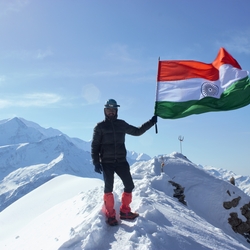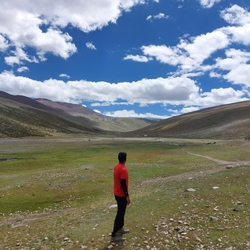There are many ways of climbing uphill on your skis. Broadly speaking, these are classified into two categories: Gliding techniques and non-gliding techniques.
In the Basic Skiing Course, we will be learning the non-gliding techniques:
1. Side-stepping
2. Herringbone (optional)
The non-gliding techniques are a slower form of travel than gliding techniques. This is the major reason why it is not preferred by experienced and advanced skiers. However, while going cross-country skiing, the terrain and slopes are not as chiselled out as the groomed slopes of a resort.
You are likely to come across terrain and slopes that are unpredictable. During times like these, the non-gliding techniques are a sure-fire way to navigate such terrain without the fear of slipping/sliding downhill.
In fact in the Basic Skiing Course, you are taught how to climb uphill on your skis using side stepping before downhill skiing.
Climbing uphill on your skis using Side-Stepping
1. Position your Skis side-by-side horizontally across the slope.
2. If your right foot is above your left foot, then dig in the outer edge of your right ski into the snow.
3. Shift your entire body weight onto the outer edge of your right ski. If you are doing this right, you will notice that you are now locked in position (without sliding/slipping downhill) with your left foot free to move.
4. Lift your left ski and place it on its inner edge below your right foot.
5. Press into the inner edge of your left ski by shifting your weight onto it while simultaneously lifting your right ski to take a step forward.
6. Ensure the outer edge of your right ski is engaged while placing your ski on the ground. This ensures you are locked in place allowing your left foot freedom of movement (Step 3).
7. Repeat the process as many times as needed to climb uphill.

Note: The picture has been slightly exaggerated to bring out how the edges of the skis need to be engaged.
Climbing uphill on your skis using Herringbone
Herringbone is a tad more difficult to master than side-stepping. So, although it is not traditionally taught in the Basic Skiing Course by Bikat Adventures, you can give this technique a try once you feel more confident about climbing uphill using side stepping.
1. For herringbone, place your skis vertically along the slope in a V position, i.e., place the tails of your skis close together and spread the tips of your skis wide apart.
2. Engage the inner edges of both your skis, i.e, roll in your knees towards each other such that your body weight is evenly distributed across the inner edge of your left and right ski, thereby pressing them firmly into the snow below.
3. Lean your chest slightly forward. This will be your starting position.
4. If you are doing this right, you will notice that you are locked in place without slipping/sliding downhill.
5. Now simply move forward by place one ski in front of the other, as you would when walking, while maintaining the V position and engaging the inner edges of the Skis. Shift your weight from one inner edge to the other while doing so.
6. This is the herringbone technique for climbing uphill.

Handy Tips:
1. In both sidestepping and herringbone, it is crucial you engage the respective edges of the skis at all times. Do not place your skis flat on the snow as they would loosen the grip on the floor leaving you prone to slipping.
2. Understanding the fall line can come in handy while navigating uphill on your skis using side-stepping. In skiing, a fall line refers to the line that traces the steepest descent down a mountain, i.e, the path an object would take if it were free to move downhill under the force of gravity.
Ensure the bases of your skis are at a 90-degree angle to this fall-line while side stepping at all times. When you find yourself slipping downhill, despite engaging the edges correctly while side stepping, it usually means that the base of your ski is not perpendicular to the fall line. Often, adjusting this angle by taking into account the direction in which you are slipping can help you move steadily uphill.
Lastly, as with any sport, every technique takes time and lots and lots of practice to master. Don’t get disheartened if you find these techniques difficult to adopt at the beginning. Many a time during your Basic Skiing Course, you will find yourself wanting to simply remove your skis and walk uphill in your ski boots instead because it is less tiring on your body.
While this may not make much of a difference during the Basic Skiing course, learning to climb uphill on your skis is a non-negotiable skill you need to pick up if you have plans of pursuing the sport of skiing more seriously.
So, do try and adopt these uphill climbing techniques, for small distances at least, every time you ski down the hill. After a couple of days, you will find that your body getting more attuned and comfortable with climbing uphill on your skis directly.






